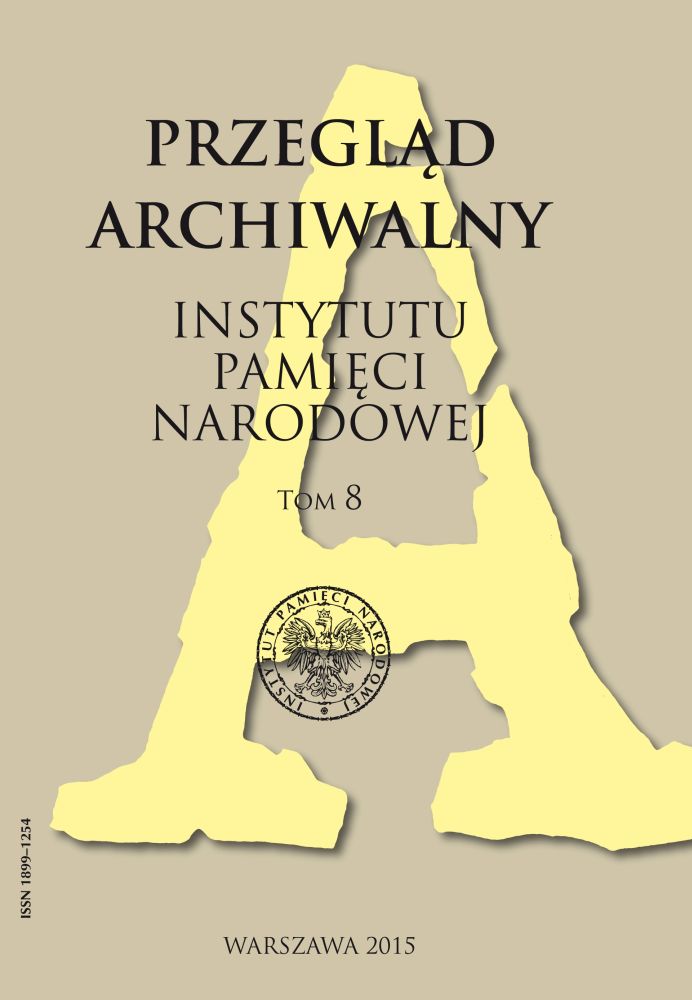Likwidacja getta w Otwocku (19 sierpnia 1942 r.) w relacji ks. ppłk. Jana Wojciechowskiego SJ
Przegląd Archiwalny Instytutu Pamięci Narodowej, Nr 8 (2015), strony: 225–246
Data publikacji: 2023-04-05
Abstrakt
The Germans established the ghetto in Otwock in autumn in 1940. After the Warsaw ghetto it was the biggest object of this type in the Warsaw District of General Governorship; about 14–15 thousand of Jews were closed in it. In August 1942 the Germans liquidated the Otwock ghetto murdering its inhabitants on the spot or taking them to the camp for mass extermination in Treblinka. The eye witness of these events was a Jesuit, Rev. Jan Wojciechowski – a soldier of the war of 1939, a priest of the Home Army, a participant of the Warsaw uprising, in the years 1946–1949 a head of the Polish Church for the British zone in the occupied Germany, Polish community activist in the Unites States of America. In April 1947 Rev. Wojciechowski prepared the account where he described the history of the ghetto in Otwock. However, the narration of this source focused mostly on the liquidation of the ghetto and included numerous details that had been unknown in that up to that time.
Inne teksty tego samego autora
- Daniel Gucewicz, Bartłomiej Noszczak, „Zupełnie obce ciało”. Duszpasterstwo wojskowe w świetle dokumentów Głównego Zarządu Politycznego Wojska Polskiego z lat 1962–1964 , Przegląd Archiwalny Instytutu Pamięci Narodowej: Nr 17 (2024)
- Michał Kurkiewicz, Bartłomiej Noszczak, Okiem sowietnika – raport doradcy z Ministerstwa Bezpieczeństwa Państwowego ZSRS o pracy polskiego Ministerstwa Bezpieczeństwa Publicznego (8 czerwca 1951 r.) , Przegląd Archiwalny Instytutu Pamięci Narodowej: Nr 3 (2010)
- Bartłomiej Noszczak, Kryptonim „Fala” – działania SB prowadzone w związku z potajemnym wywiezieniem Obrazu Nawiedzenia z Jasnej Góry (14–20 czerwca 1972 r.) , Przegląd Archiwalny Instytutu Pamięci Narodowej: Nr 4 (2011)
- Bartłomiej Noszczak, Polityka władz PRL wobec izolowanego biskupa Czesława Kaczmarka (1953–1956) , Przegląd Archiwalny Instytutu Pamięci Narodowej: Nr 2 (2009)
- Bartłomiej Noszczak, Ramowy plan Centralnego Zespołu Koordynacyjnego Ministerstwa Spraw Wewnętrznych dotyczący zabezpieczenia państwowych i kościelnych uroczystości jubileuszowych w 1966 r. , Przegląd Archiwalny Instytutu Pamięci Narodowej: Nr 11 (2018)
 Język Polski
Język Polski
 English
English


 PDF
PDF
